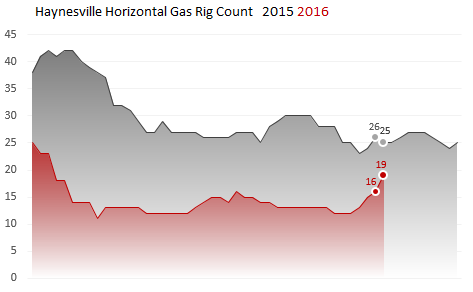This week's rig count marks the fourth week of increasing rig power in the Haynesville, confirming that a low $3 forward strip is attractive to some producers.
Gas output from the HS has been on a shallow decline since the end of 2013, falling from about 4BCF to 3.5BCFD, after a sharp 2-year decline from 7.2 to 4.0 BCF in 2012-13. The drilling improvements recently reported by Chesapeake suggest that a horizontal rig count >20 might be sufficient to spark output growth again soon. From their Q2 Earnings Call:
In the Haynesville, we have recognized transformational value improvements this quarter. We continue to lead the industry on long-lateral technology with six 10,000 foot wells drilled to date. We have recently tested the largest completion in Chesapeake's history with over 30 million pounds of sand being pumped in the well. Results have been very impressive with a restricted initial rate of 38 million cubic feet per day and a flowing pressure of approximately 7,500 psi. We call this new era in completion technology proppant-geddon. And we've not yet reached the point of diminishing returns in the Haynesville and we plan additional tests up to 50 million pounds in the back half of the year. We look forward to sharing more results of the proppant-geddon program in the future.
It won't take many wells producing at a 38 million a day (restricted IP) to generate output growth. Chesapeake went on to say, in the Q&A, that they planned to keep 3 rigs running in the HS and that rigs are spudding about 1 well per month. That's a pace of 36 wells per year. If we assumed the other 16 rigs in the play were similarly productive (which I don't, but for argument's sake let's say), we would see about 225 wells spud per year, at IP rates around 40 MMCFD. It doesn't take a petroleum engineer to realize that this basin would spring to life.
Here's the production profile since development began in 20018:


